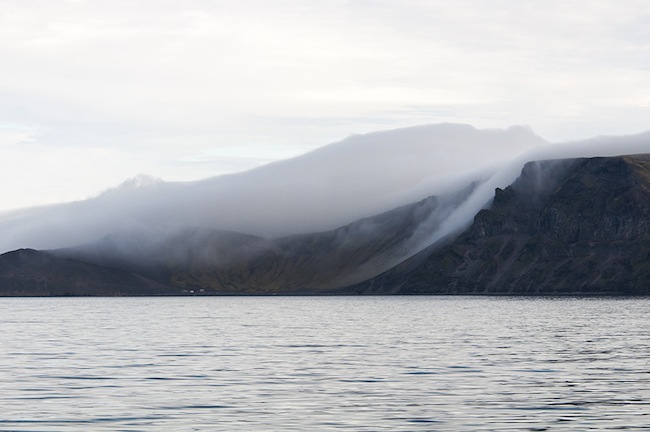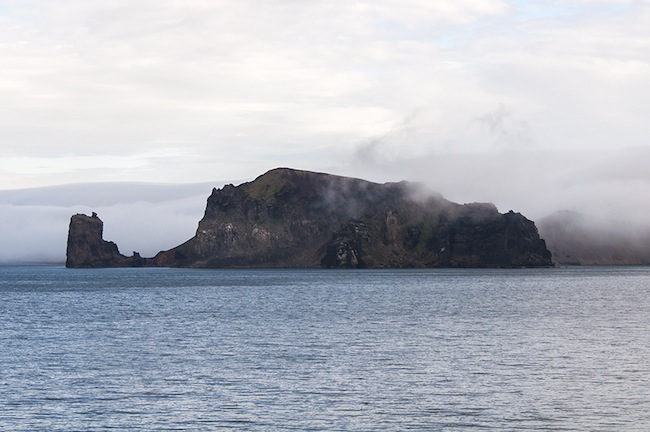Dispatch 12: Jan Mayen
19th August 2012
 |
“Good luck describing this place,” said Bob as we stood on the bridge wing peering through binocs at still another spectacular Arctic sight, the ice-covered, active volcano called Beerenberg on Jan Mayan Island. It rides atop a hot spot on an intersection of bathymetric (submerged) features, which, if we could see them, would rival for spectacular viewing anyplace in the hemisphere, including Greenland, and they’d be even harder to describe.
The Jan Mayan Fracture Zone stretches off to the west; Mohn Ridge runs northward from the island; and the Jan Mayan Ridge reaches southward. Together they officially demark the boundaries between the Greenland Sea, the Iceland and Norwegian Seas. All three features are associated with the far larger Mid-Atlantic Ridge, a mountain range that weaves, like the seam in a baseball, from out of the High Arctic, beneath the equator, on to Antarctica. The sea floor is literally spreading along the peaks of the Atlantic Ridge, exposing to the cold sea Earth’s molten innards. Europe and North America are literally growing further and further apart along the Mid-Atlantic Ridge at about the same rate of growth as our fingernails. Some of this deep-Earth heat has fought its way out of the intersection of the ridges and the fracture zones to vent deep-Earth heat through the volcano here on Jan Mayan island in the middle of Arctic nowhere.
 |
We knew before we boarded JCR in Iceland (through the middle of which runs the Mid-Atlantic Ridge; you can walk in the fissure) that one of Bob’s CTD sections would run “right through” Jan Mayan Island, but by lunchtime yesterday we’d relinquished hope of seeing it—fog again. A couple hours later, however, Second Mate Piers phoned us in the lab. “Fog’s lifted. The volcano’s visible.” We beat it to the bridge. Piers was there, laying out a safe course one mile off its west side, the Captain was at the helm with the Pilot Book at his elbow, and Bob was already on the bridge wing with his binoculars. Photographers grouped on the bow, some of the crew lined the starboard rail, and I heard the temporarily off-duty CTD watch standers exclaiming from up on the monkey island. We’d gotten lucky still again.
'The sea floor is literally spreading along the peaks of the Atlantic Ridge, exposing to the cold sea Earth’s molten innards.' |
The 30-mile-long island trends SW to NE, and with the east side enshrouded in fog, we steamed along the west coast where naked, round-topped, 1,500-meter mountains veined with volcanic ash and red traces of iron drop to a short, flat beach. There are really two parts to the island, mountainous Sor-Jan linked by a low-lying neck to Nord-Jan where the great conical volcano, with a hat of fog, soars almost 2,200 meters. For a tiny, remote, essentially uninhabitable island, Jan Mayan was one of the most squabbled over spots in the Arctic, as the long list of “discoverers” indicate: Henry Hudson (Dutch) named it “Hudson’s Touches” in 1607; Thomas Marmaduke (English), “Trinity Island” in 1611 or 1612; Jean Vrolicq (French), “Isle of Richelieu,” 1612, and so on. Dutch sources of the time refer to it as the Eylant in questie, the disputed island. The object of the conflict wasn’t the riches of the island itself, but the profusion of whales that frequented its waters, and with the same as upshot as the still earlier competition on Spitsbergen, Europeans killed all the whales. Much later it was fought over by the Allies and Germans in the so-called Weather War during WWII. Jan Mayan was situated beneficially to both sides, since eastbound weather systems pass there before arriving on Western European shores. Now it’s indisputably Norwegian; they maintain a weather station at a spot with the improbable name Hochstetterkrateret.
 |
 |
 |
Bob and Kjetil are searching for a piece of the EGC that careens off at depth from the Greenland shelf break heading for a chink in the Jan Mayan Ridge and then—perhaps—flowing with the bathymetry southward before rejoining its kin. Perhaps not. Anyway, that’s what physical oceanographers do, they follow the water. Until they learn where it goes and why, they can’t be asked to explain the broader system dominating these messy waters, let alone what it all means for climate and the rest. So tomorrow we’ll go more deeply (no pun) into the vital tool we’ve referred to then and now, the CTD and some of the findings it’s hauled up from the stubborn abyss.
















